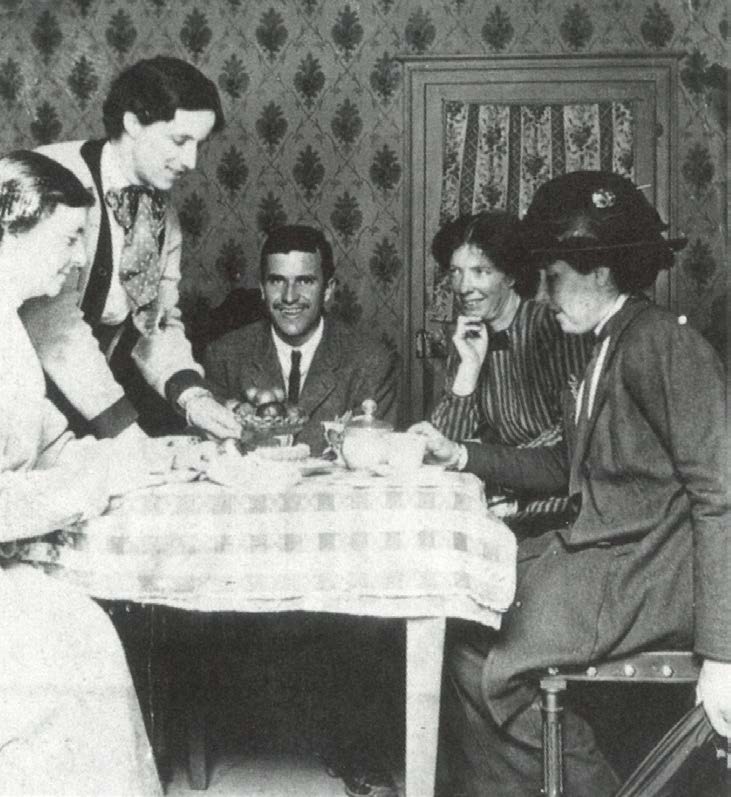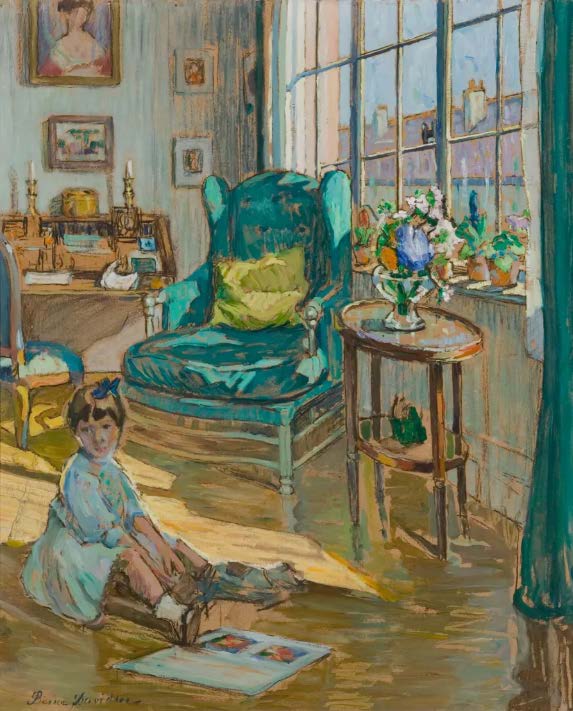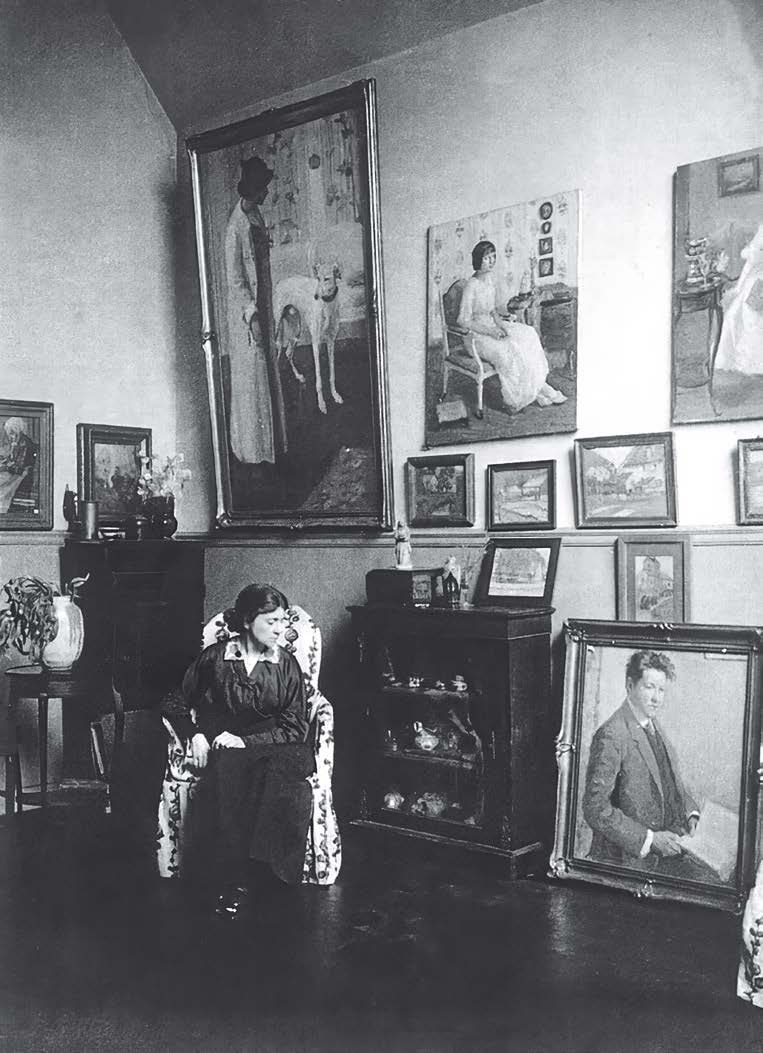Bessie Davidson (1879 – 1965) Lots 1 – 2
DH2025 Art Catalogue (27 August) LR2.jpg

Donald Hankey, Margaret Preston and H. Hankey in
Faucogney-et-le-Mer in France, 1912
Bessie Davidson’s 1928 solo exhibition at Galerie Ecalle in Paris prompted the art critic Pierre Müller to ask, ‘Does art have a nationality?’1 Aware of Davidson’s antipodean origins, as well as the fact that Paris (and France more broadly) was home to a significant number of expatriate women artists from all over the world, he concluded, ‘I do not think so. Bessie Davidson, like Mary Cassat, like Beatrice How, is as much one of us as of elsewhere, she is from any land where there is a taste for beauty, grace and refinement.’2
Part of a group of trailblazing Australian women artists who travelled to Europe during the first decades of the twentieth century, Davidson went to Paris primarily seeking to expand her artistic education. The City of Light offered a pluralist and progressive approach to art with private academies that provided tuition to women, as well as opportunities for them to exhibit alongside their male counterparts. In the words of Australian writer Edith Fry, Paris was ‘the only truly cosmopolitan city of the world for artists, whose work stands a better chance there than in any other art centre of being judged on its merits.’3 Being away from home also had the added advantage of freeing these artists from family expectations and gendered social conventions of marriage and motherhood. While many of these women returned home after their study and travels, sharing what they had learned of international modernism both informally and in organised classes, Davidson and a small number of others – including Agnes Goodsir, Anne Dangar and Stella Bowen – remained, establishing successful careers and living overseas for the rest of their lives, part of a transnational group of artists whose experiences and work radically extend traditional narratives and definitions of Australian art.4
DH2025 Art Catalogue (27 August) LR.jpg

Davidson was born in Adelaide in 1879, the second of five children and the eldest daughter. It is likely that she undertook private lessons or studied at the Adelaide School of Design like many of her South Australian peers, however her first documented experience of formal art education was in 1899 when she attended classes with Rose McPherson. Later and better known as Margaret Preston, McPherson had recently returned to Adelaide after studying at the National Gallery School in Melbourne and during the years that she was Davidson’s teacher, the two women established a strong friendship. In 1904 they sailed together to Europe, initially studying in Munich as a concession to Davidson’s father who requested that they did not go to Paris ‘because Frenchmen are so immoral.’5 The modern art they saw there shocked and disturbed them however, prompting McPherson to declare with characteristic directness that ‘half German art is mad and vicious and a good deal of it is dull’6, and by the end of the year they had left for Paris. It is possible that they attended classes run by fellow Australian artist Rupert Bunny, and in 1906 Davidson (and possibly also McPherson) enrolled at the Académie de la Grande Chaumière in the heart of Montparnasse.7 Both artists achieved some success with paintings being accepted for display in the Salon des Artistes Françaises and as they sailed home to Australia at the end of 1906, they were already dreaming of their return.
With an allowance that supported income from painting sales, Davidson returned to Paris in 1910. She reconnected with friends including the artist René-Xavier Prinet, who had taught her at la Grande Chaumière – probably also taking classes with him – and in 1912 moved to Montparnasse, where there was a large community of expatriate artists, into a studio apartment on Rue Boissonade. Located on the second floor of a late nineteenth-century building, the apartment had high ceilings and large windows that looked out over a central courtyard. Recorded in contemporary photographs and many of Davidson’s own paintings, the interior incorporated a ‘round mahogany Empire dining table and… distinctive curved-back chairs, the small octagonal sewing table, the little bergère chair with its loose cover of sprigged cretonne and the Louis XV fauteuil (armchair) upholstered in petit-point. There are Persian rugs on the polished floorboards and heavy purplish curtains… the whole studio heated by a pot-bellied stove in the middle of the room.’8
DH2025 Art Catalogue (27 August) LR.jpg

studio, 1913
Apart from visits to Australia in 1914 and again in 1950, Davidson remained in France, a resident of Rue Boissonade, for the rest of her life. As well as speaking fluent French, she developed a wide network of friends, was well-connected within the artistic community and established a successful career, exhibiting regularly at the Salons and gaining much critical attention for her work. In 1920, she was elected as an associate member of the Société Nationale des Beaux-Arts, only the fourth Australian to receive this acknowledgement – following George Lambert, Rupert Bunny and George Coates – and the first Australian woman ever to do so. Two years later, she was the first Australian artist to receive full membership. Davidson was a founding member of the Salon des Tuileries (1923) and the Société des Femmes Artistes Modernes (1930), serving as vice-president for its first decade of operation. Arguably the greatest accolade, however, came in 1931 when Davidson was made a Chevalier de la Légion d’Honneur for services to the arts, the only Australian woman to have received this honour at the time.9
Primarily painted in tempera and oil, Davidson’s oeuvre includes the images of women and children in domestic settings for which she is best known, including Jeune fille au mirroir (Young girl with mirror), 1914 (National Gallery of Victoria) and An interior, c.1920 (Art Gallery of South Australia), as well as portraits and still lifes. From the mid-1920s she also increasingly painted the landscape, often recording quick gouache impressions of views seen during her extensive travels through country France and further afield. The Art Gallery of South Australia acquired a portrait of her friend, the artist-potter Gladys Reynell, in 1908, but Davidson’s absence from the local art scene meant that it is only in relatively recent times that her art has been collected by most Australian State galleries.10 Reflecting the sentiment that ‘Bessie Davidson [was] the most Parisian of them all’11, her work was acquired by the French State during her lifetime however and is represented in several French collections including the Centre Georges Pompidou, Paris.
1. Pierre Müller, cited in Little, P., A Studio in Montparnasse: Bessie Davidson: An Australian Artist in Paris, Craftsman House, Melbourne, 2003, p. 100
2. ibid.
3. Edith Fry, cited in Speck, C., ‘Paris Calls’ in Bessie Davidson: An Australian Impressionist in Paris, exhibition catalogue, Bendigo Art Gallery, Bendigo, 2020, p. 17
4. See Rex Butler and A.D. S. Donaldson, ‘French, Floral and Female: A History of UnAustralian Art 1900 – 1930 (part 1), Emaj, issue 5, 2010, at: https://www.index-journal.org/media/pages/emaj/issue-5/french-floral-and... (accessed July 2025) and Freak, E., Lock, T., and Tunnicliffe, W., ‘Dangerously Modern’ in Dangerously Modern: Australian Women Artists in Europe 1890 – 1940, Art Gallery of New South Wales and Art Gallery of South Australia, Sydney and Adelaide, 2025, pp. 13 – 19
5. Little, op. cit., p. 25
6. ibid., p. 29
7. See Taylor, E., ‘Modern Women: Margaret Preston and Bessie Davidson’ in Australian Impressionists in France, National Gallery of Victoria, Melbourne, 2013, pp. 97 – 101
8. Little, op. cit., p. 56
9. All biographical information is drawn from Little, op. cit.
10. For example, the Queensland Art Gallery I Gallery of Modern Art first acquired Davidson’s work in 1977; the National Gallery of Victoria’s first acquisitions were in 2020; and the Art Gallery of New South Wales’ first acquisition occurred in 2023.
11. Edouard Sarradin, cited in Little, op. cit., p. 108
KIRSTY GRANT